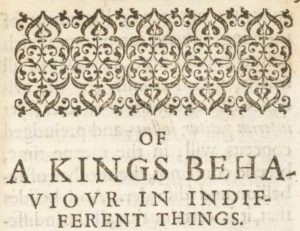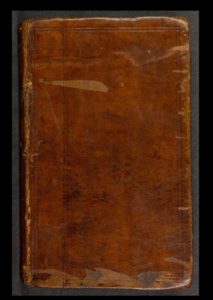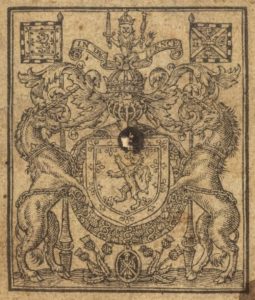Basilikon dōron, or His Maiesties instrvctions to his dearest sonne, Henry the prince
We are delighted that students on Dr Amy Blakeway’s ‘Mary Queen of Scots, France, England and Ireland’ module (MO4807) last year were again asked to submit a blog post as part of their course. Here is the next in a small series of blogs which reflect on the rare books with which the students engaged during their remote studies last year.
The Basilikon dōron, or His Maiesties instrvctions to his dearest sonne, Henry the prince was originally published in 1599 in Edinburgh in a short run of only seven copies, which were distributed to the King’s friends and family members. As the title suggests, the work purported to be a practical guide to kingship for his oldest son, and included James’s thoughts on a king’s duty in his office and to God, and his own personal behaviour.

Apart from the content of the work, the copy under discussion, which was published in 1603, has almost nothing in common with the work’s original form, even in terms of its language, having been translated into English from Middle Scots. It was published by John Norton and printed by Felix Kingston for the London market in anticipation of the coronation of James as King of England. As one of approximately 10,500 copies, this publication had a far larger scope and intended audience than the original.

It has been described by historians as the seventeenth-century equivalent of a modern day coronation mug; it was above all a commemorative trinket, but lacked material value. This, at least in part, rings true in regards to our copy. While the original print was of good quality and ornamented with woodcuts, its less than illustrious binding of barely decorated calf leather added after the work was purchased, suggests that its owners did not consider it valuable enough to warrant fine adornments.
Yet, unlike a coronation mug, this book is far from an empty vessel with an ornamental priority. This copy shows signs of careless handling: there are holes in the title page, caused by spilled ink; the pages are torn and repaired and torn again; and there are suspicious stains, about the cause of which we can only speculate. These marks demonstrate that this book was a working copy, and that, far from spending its life collecting dust on an old bookshelf, its readers engaged with its content. While no annotations occupy the margins, the spots of ink on the title page suggest that a reader, perhaps Jane Hayford who wrote her name above James’s own, took notes from the work.


This tome may have arrived in the modern day as a rough-around-the-edges artefact, far removed from what we as a modern audience associate with the refinement and splendour of monarchy, but its royal roots are evident to those willing to look beyond its shoddy appearance. Before the beginning of the text itself, the coat of arms on the title page ostentatiously announces its royal association, invoking the imagery of thistles, unicorns, and the imperial crown utilized by James’ predecessors, anchoring the book in Scotland’s historical narrative.

James’ note to the reader (which did not appear in the original), makes that connection yet more tangible. This serves the true purpose of this iteration of the Basilikon dōron. In a form relatively accessible to the more learned of his future English subjects, James took the opportunity to introduce himself to them, and to elaborate on the style of kingship they would soon experience. This book is an object strongly rooted in Scotland, its history, and its royalty, and yet was anglicised and brought with authority into the forefront of English consciousness, much like the man who penned its original form.
Verity Jamieson
2020/2021
Bibliography
Primary
Stewart, James, Basilikon dōron, or His Maiesties instrvctions to his dearest sonne, Henry the prince, (London, 1603) copy in St Andrews, University of St Andrews Library, Special Collections Rare Books, TypBL.C03KJ.
Secondary
Foot, Mirjam M., ‘Bookbinding’, in John Barnard, D. F. McKenzie, Maureen Bell (eds.), The Cambridge history of the book in Britain. Vol. 4, 1557-1695, (Cambridge, 2002), pp. 620-631.
Sommerville, Johann P., ‘Introduction’, in Johann P. Sommerville (ed.), James VI and I: Political Writings, (Cambridge, 1994).
Wormald, Jenny, ‘James VI and I, Basilikon Doron and The Trew Law of Free Monarchies: The Scottish Context and the English Translation’, in Linda Levy Peck (ed.), The Mental World of the Jacobean Court, (Cambridge, 1991), pp. 36-54.